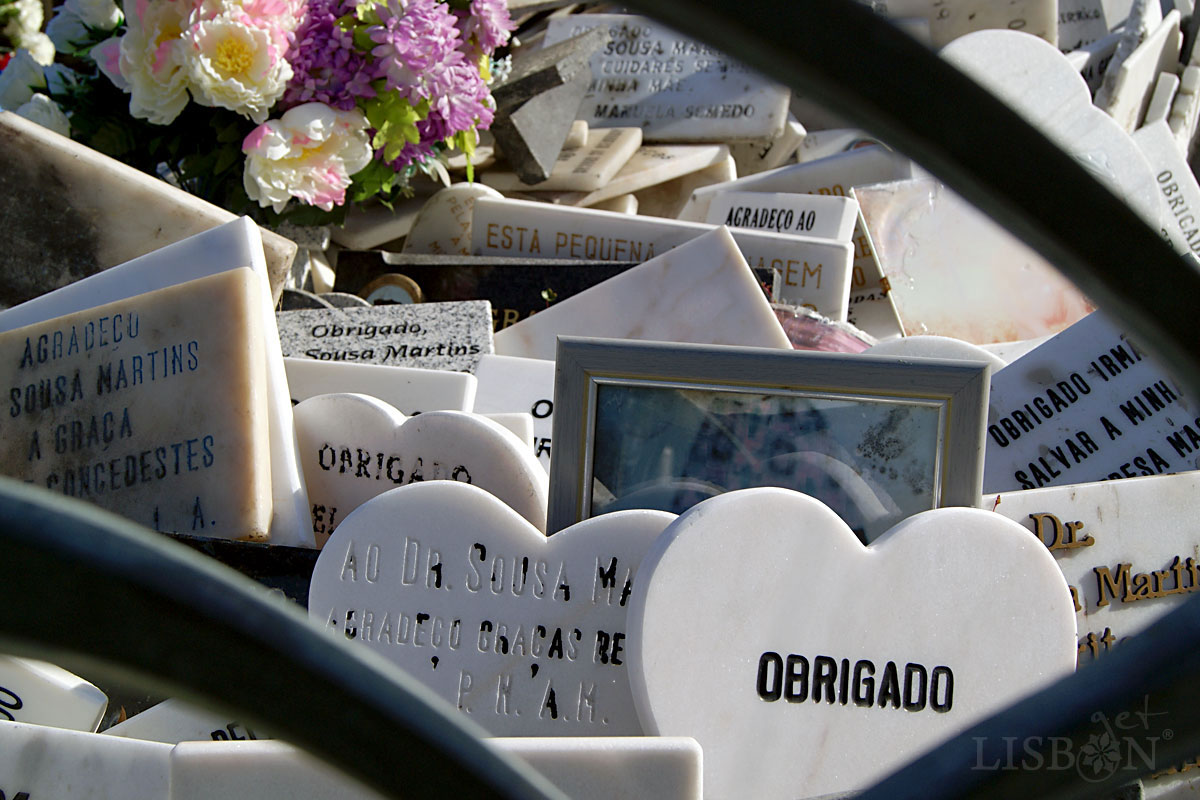On top of Santana Hill, in front of the Faculty of Medical Sciences, there exists a monument that is particularly interesting, the monument of Dr. Sousa Martins.
Around it are thousands of ex-votos of different typologies. Figures in wax, stone plaques engraved with thanks, photographs, notes, flowers … testimonies of healings and desperate requests for miraculous interventions have been heaped over the last 110 years. Were you surprised?
At the base of this monument we observe the allegory of Science, personified in a female figure holding a book, seated on reflection. On top of a tall stone column stands the bronze statue of a man wearing a teacher’s robe; a figure standing with an expressive attitude of someone who talks or gives a speech.
But Who Is Sousa Martins? Why Do They Give Him Such Devotion?

We take advantage of the anniversary of the birth of José Tomás de Sousa Martins (March 7, 1843) to tell you about this man, famous and esteemed both for his brilliant professional abilities and commitment and for his compassionate character.
He was born in Alhandra, near Lisbon, a village situated in the north bank of the Tagus river estuary.
At the age of 12 he came to the capital, under the protection of a pharmacist uncle that initiated him into the art of handling plants. He graduated in Pharmacy at the early age of 21 and in Medicine two years later. Being a standout student for his grades, he was soon distinguished by the quality of his works and as a member of several scientific institutions.
With a career dedicated to the practical and theoretical aspects of medicine, he gave special relevance to the human relationship between the doctor and the patient. One of his lessons was particularly well-known when he argued that if a doctor had nothing to alleviate a patient’s suffering, he still had a smile.
He was famous not only as a brilliant intellectual and scientist, but also for his social position as the doctor of the Royal Family or as the representative of Portugal in international events. But he became especially esteemed for being generous and not charging the less fortunate and by working tirelessly in hospitals, which earned him the nickname of the Father of the Poor.
He had a major role in the fight against tuberculosis, a very active disease in the 19th century, studying and defending the creating of sanatoriums in the region of Serra da Estrela, which came to fruition after his death.
The terrible disease that he fought against, associated with a heart injury, ended up victimising him. At the age of 54, confronted with the inexistence of treatment, he commits suicide, leaving, in the words of King Carlos I, the kingdom deprived of its greatest Light.


A Cult That Still Remains Today

After understanding the talent and the generosity of Sousa Martins, we can check his qualities in the words of the poet and writer Guerra Junqueiro (1850-1923):
‘An eminent man who radiated love, enchantment, hope, joy and generosity. He was a friend, caring and dedicated to the poor and the poets. His hand guided. His heart forgave. His mouth taught. He honoured the Portuguese medicine and everyone who sought in him the cure for all their evils.’
This terrific personality originated a laic cult, but no less imbued with spirituality. The people pay homage to his talent and character of an unequalled man. The doctor who frequently gave, in addition to the prescriptions of the medicines, the money necessary for their acquisition.
His miraculous healing abilities, which have been attributed to him while still alive, extend beyond his death. Being called to intervene, as if he were a Catholic saint, he receives the gratitude of believers who, on the anniversary of his birth or death, pay homage to him. On these occasions, there are pilgrimages in Lisbon to the monument that we’re talking about or to the cemetery of Alhandra where his mortal remains are, keeping the cult alive 120 years after his death on August 18, 1897.
| Never miss another article | Subscribe here |
A Few Curious Facts

The bronze statue of Dr. Sousa Martins, of the authorship of the sculptor Costa Mota (uncle), was made in the foundry of the Army Arsenal that was situated near the National Pantheon. Its plaster cast is exposed in the House of Plasters next to the others, from which stands out the plaster cast of the statue of King José I of the authorship of Machado de Castro.
The monument that we have today in Campo Mártires da Pátria was inaugurated in 1907 and is the second monument installed there. The first one, by the sculptor Aleixo Queirós Ribeiro, was built but removed shortly after, due to harsh criticism. In this one, Dr. Sousa Martins was sitting in a chair on the base of the monument, holding a book in his hand. If, on the one hand, he showed a more passive attitude, on the other, perhaps his human side was more present. This sculpture was closer to the Art Nouveau style, while the current one is more connected to a classicist approach.
Controversy and tastes aside, Dr. Sousa Martins’ personality was undoubtedly worthy of a monument that immortalizes him in this emblematic square in Medicine Hill.
The project getLISBON has been very rewarding and we want to continue revealing the singularities of fascinating Lisbon.
Help us keep this project alive!
By using these links to make your reservations you’ll be supporting us. With no extra costs!
• Looking for a different experience? We can create a customised itinerary based on your interests. Contact us!
• Or if you prefer tours and other activities in various destinations, take a look at GetYourGuide.
• Save time and money with a flexible Lisbon Card!




